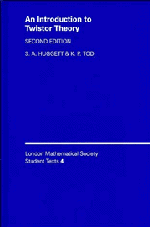Book contents
- Frontmatter
- Contents
- Preface
- Preface to the second edition
- 1 Introduction
- 2 Review of Tensor Algebra and Calculus
- 3 Lorentzian Spinors at a Point
- 4 Spinor Fields
- 5 Compactified Minkowski Space
- 6 The Geometry of Null Congruences
- 7 The Geometry of Twistor Space
- 8 Solving the Zero Rest Mass Equations I
- 9 Sheaf Cohomology and Free Fields
- 10 Solving the Zero Rest Mass Equations II
- 11 The Twisted Photon and Yang–Mills Constructions
- 12 The Non-Linear Graviton
- 13 Penrose's Quasi-Local Momentum and Angular Momentum
- 14 Functionals on Zero Rest Mass Fields
- 15 Further Developments and Conclusions
- 16 Hints, Solutions and Notes to the Exercises
- Appendix The GHP Equations
- Bibliography
- Index
1 - Introduction
Published online by Cambridge University Press: 25 January 2010
- Frontmatter
- Contents
- Preface
- Preface to the second edition
- 1 Introduction
- 2 Review of Tensor Algebra and Calculus
- 3 Lorentzian Spinors at a Point
- 4 Spinor Fields
- 5 Compactified Minkowski Space
- 6 The Geometry of Null Congruences
- 7 The Geometry of Twistor Space
- 8 Solving the Zero Rest Mass Equations I
- 9 Sheaf Cohomology and Free Fields
- 10 Solving the Zero Rest Mass Equations II
- 11 The Twisted Photon and Yang–Mills Constructions
- 12 The Non-Linear Graviton
- 13 Penrose's Quasi-Local Momentum and Angular Momentum
- 14 Functionals on Zero Rest Mass Fields
- 15 Further Developments and Conclusions
- 16 Hints, Solutions and Notes to the Exercises
- Appendix The GHP Equations
- Bibliography
- Index
Summary
Twistor Theory began as a subject in the late 1960's with the appearance of Penrose's two papers (1967, 1968a). A more definitive statement of its aims and accomplishments was ‘Twistor Theory: An Approach to the Quantisation of Fields and Space-time’ (Penrose and MacCallum), which appeared in 1973.
What is apparent from the start is the breadth of application which Roger Penrose saw for it. In the decades since then the subject has grown in different direction to the extent that different traditions have emerged.
There is a purely mathematical strain which refers to the Penrose Transform and is interested in its geometrical and complex analytic features, frequently in a positive definitve setting.
There is a quantum field theoretic strain concerned with elementary particles and their interactions in Minkowski space.
There is a modest point of view which simply holds that the theory is useful for solving some non-linear equations and the object is to discover which ones, and there is a full-blooded strain which holds that the repeated occurence and usefulness of complex numbers and complex analyticity tells one something fundamental about the physical world.
The full-blooded strain of twistor philosophy may be seen in for example (Penrose 1975). One place where the diversity of twistor theory is manifest is the Twistor Newsletter, an informal publication produced by the Oxford group about twice a year. The content of the first ten Newsletters was published as ‘Advances in Twistor Theory’ (Hughston and Ward 1979) and later articles were collected in ‘Further Advances in Twistor Theory’ (Mason and Hughston 1990).
- Type
- Chapter
- Information
- An Introduction to Twistor Theory , pp. 1 - 4Publisher: Cambridge University PressPrint publication year: 1994

